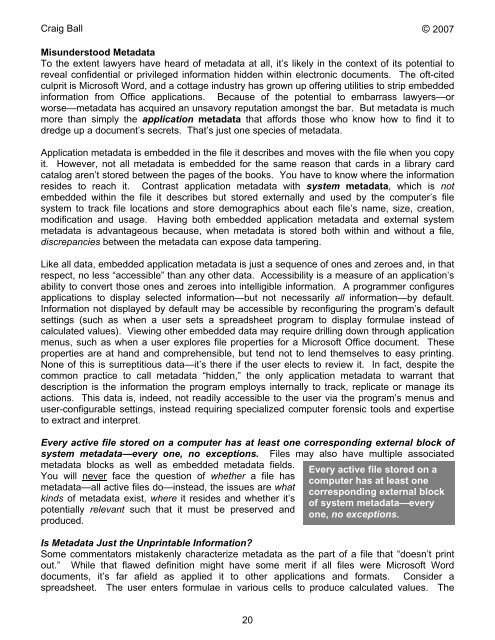Six Articles on Electronic - Craig Ball
Six Articles on Electronic - Craig Ball
Six Articles on Electronic - Craig Ball
Create successful ePaper yourself
Turn your PDF publications into a flip-book with our unique Google optimized e-Paper software.
<strong>Craig</strong> <strong>Ball</strong> © 2007<br />
Misunderstood Metadata<br />
To the extent lawyers have heard of metadata at all, it’s likely in the c<strong>on</strong>text of its potential to<br />
reveal c<strong>on</strong>fidential or privileged informati<strong>on</strong> hidden within electr<strong>on</strong>ic documents. The oft-cited<br />
culprit is Microsoft Word, and a cottage industry has grown up offering utilities to strip embedded<br />
informati<strong>on</strong> from Office applicati<strong>on</strong>s. Because of the potential to embarrass lawyers—or<br />
worse—metadata has acquired an unsavory reputati<strong>on</strong> am<strong>on</strong>gst the bar. But metadata is much<br />
more than simply the applicati<strong>on</strong> metadata that affords those who know how to find it to<br />
dredge up a document’s secrets. That’s just <strong>on</strong>e species of metadata.<br />
Applicati<strong>on</strong> metadata is embedded in the file it describes and moves with the file when you copy<br />
it. However, not all metadata is embedded for the same reas<strong>on</strong> that cards in a library card<br />
catalog aren’t stored between the pages of the books. You have to know where the informati<strong>on</strong><br />
resides to reach it. C<strong>on</strong>trast applicati<strong>on</strong> metadata with system metadata, which is not<br />
embedded within the file it describes but stored externally and used by the computer’s file<br />
system to track file locati<strong>on</strong>s and store demographics about each file’s name, size, creati<strong>on</strong>,<br />
modificati<strong>on</strong> and usage. Having both embedded applicati<strong>on</strong> metadata and external system<br />
metadata is advantageous because, when metadata is stored both within and without a file,<br />
discrepancies between the metadata can expose data tampering.<br />
Like all data, embedded applicati<strong>on</strong> metadata is just a sequence of <strong>on</strong>es and zeroes and, in that<br />
respect, no less “accessible” than any other data. Accessibility is a measure of an applicati<strong>on</strong>’s<br />
ability to c<strong>on</strong>vert those <strong>on</strong>es and zeroes into intelligible informati<strong>on</strong>. A programmer c<strong>on</strong>figures<br />
applicati<strong>on</strong>s to display selected informati<strong>on</strong>—but not necessarily all informati<strong>on</strong>—by default.<br />
Informati<strong>on</strong> not displayed by default may be accessible by rec<strong>on</strong>figuring the program’s default<br />
settings (such as when a user sets a spreadsheet program to display formulae instead of<br />
calculated values). Viewing other embedded data may require drilling down through applicati<strong>on</strong><br />
menus, such as when a user explores file properties for a Microsoft Office document. These<br />
properties are at hand and comprehensible, but tend not to lend themselves to easy printing.<br />
N<strong>on</strong>e of this is surreptitious data—it’s there if the user elects to review it. In fact, despite the<br />
comm<strong>on</strong> practice to call metadata “hidden,” the <strong>on</strong>ly applicati<strong>on</strong> metadata to warrant that<br />
descripti<strong>on</strong> is the informati<strong>on</strong> the program employs internally to track, replicate or manage its<br />
acti<strong>on</strong>s. This data is, indeed, not readily accessible to the user via the program’s menus and<br />
user-c<strong>on</strong>figurable settings, instead requiring specialized computer forensic tools and expertise<br />
to extract and interpret.<br />
Every active file stored <strong>on</strong> a computer has at least <strong>on</strong>e corresp<strong>on</strong>ding external block of<br />
system metadata—every <strong>on</strong>e, no excepti<strong>on</strong>s. Files may also have multiple associated<br />
metadata blocks as well as embedded metadata fields.<br />
You will never face the questi<strong>on</strong> of whether a file has<br />
metadata—all active files do—instead, the issues are what<br />
kinds of metadata exist, where it resides and whether it’s<br />
potentially relevant such that it must be preserved and<br />
produced.<br />
Every active file stored <strong>on</strong> a<br />
computer has at least <strong>on</strong>e<br />
corresp<strong>on</strong>ding external block<br />
of system metadata—every<br />
<strong>on</strong>e, no excepti<strong>on</strong>s.<br />
Is Metadata Just the Unprintable Informati<strong>on</strong>?<br />
Some commentators mistakenly characterize metadata as the part of a file that “doesn’t print<br />
out.” While that flawed definiti<strong>on</strong> might have some merit if all files were Microsoft Word<br />
documents, it’s far afield as applied it to other applicati<strong>on</strong>s and formats. C<strong>on</strong>sider a<br />
spreadsheet. The user enters formulae in various cells to produce calculated values. The<br />
20













